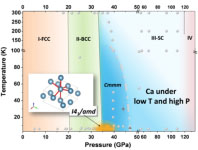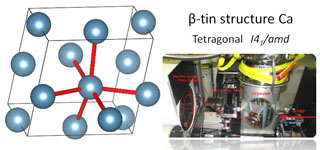 Studies of Ca at low temperatures and high pressures are important in order to understand its superconductivity. Ca holds the record for the highest superconducting critical temperature (Tc = 26 K) among elemental materials. Moreover, Ca serves as an active test case of modern theories and experiments on crystal structure and stability. In high-pressure research, Ca is one of the most studied elements.
Studies of Ca at low temperatures and high pressures are important in order to understand its superconductivity. Ca holds the record for the highest superconducting critical temperature (Tc = 26 K) among elemental materials. Moreover, Ca serves as an active test case of modern theories and experiments on crystal structure and stability. In high-pressure research, Ca is one of the most studied elements.Ca undergoes counterintuitive structure phase transitions, including the Ca-III phase where electronic transition from a normal metal to a superconductor occurs and the Tc increases with pressure from 2 K to 10 K in this region. Researchers at Carnegie and Jilin University led by Bing Li searched for a recently predicted β-tin structure and studied the stability of Ca-III phase within a wide range of pressures and temperatures.
 Using synchrotron high-pressure x-ray diffraction at cryogenic temperatures, the scientists established a new phase diagram for Ca for up to 110 GPa and 5-300 K. They discovered the long-sought for theoretically predicted β-tin structured Ca with I41/amd symmetry at 35 GPa in a small low temperature range below 10 K—findings that resolve the enigma of absence of this lowest enthalpy phase and show the experimental evidence of new structure for Ca superconductor under high pressures and low temperature [B. Lin et al., Proc. Nat. Acad. Sci. 109, 16459 (2012)].
Using synchrotron high-pressure x-ray diffraction at cryogenic temperatures, the scientists established a new phase diagram for Ca for up to 110 GPa and 5-300 K. They discovered the long-sought for theoretically predicted β-tin structured Ca with I41/amd symmetry at 35 GPa in a small low temperature range below 10 K—findings that resolve the enigma of absence of this lowest enthalpy phase and show the experimental evidence of new structure for Ca superconductor under high pressures and low temperature [B. Lin et al., Proc. Nat. Acad. Sci. 109, 16459 (2012)].Figure captions: Top: Proposed phase diagram of Ca at high pressure and low temperature, and its crystal structure with symmetry of I41/amd. Bottom: β-tin crystal structure and experimental setup at HPCAT.
